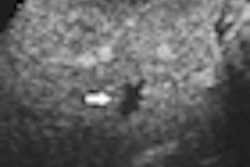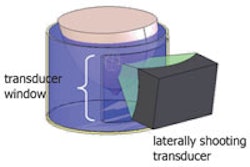Small gallbladder polyps found incidentally on ultrasound have a low risk of malignancy and do not need follow-up, according to researchers from Beth Israel Deaconess Medical Center in Boston.
In a retrospective review of 346 patients with gallbladder polyps, a study team led by Michael Corwin, MD, found that none of the polyps became malignant. The researchers also did not find any of the risky neoplastic polyps among the patients with small polyps 6 mm or less in size, potentially avoiding the need for follow-up ultrasound examinations.
"None of the gallbladder polyps we studied progressed to gallbladder cancer and none of the polyps measuring 6 mm or less were neoplastic," Corwin told AuntMinnie.com. "These are important findings because gallbladder polyps are incidentally detected frequently and the management of these lesions is controversial."
Although gallbladder polyps are incidentally detected in as many as 7% of patients receiving gallbladder ultrasound exams, clinical management of these lesions remains a clinical dilemma. Most lesions are non-neoplastic, but a malignant transformation to adenocarcinoma becomes a primary concern in the rare cases of neoplastic polyps, according to the researchers.
Seeking to determine the natural history of gallbladder polyps incidentally discovered on ultrasound and to propose management guidelines for these lesions based on polyp size, the researchers retrospectively reviewed 346 patients with incidentally detected gallbladder polyps at their institution. Patients were found by a database search for the word "polyp" in all gallbladder ultrasound examinations performed between January 1, 1999, and December 31, 2001 (Radiology, January 2011, Vol. 258:1, pp. 277-282).
Patients without a pathology report, ultrasound follow-up of at least two years, or clinical follow-up of at least five years were excluded from the study. Ultrasound exams were performed using 3.5-MHz transducers on either an iU22 (Philips Healthcare, Andover, MA), ATL 5000 (Philips), or Acuson 128 (Siemens Healthcare, Malvern, PA) scanner.
Two researchers reviewed the radiology reports -- and, if necessary, the images on a PACS workstation -- to determine the number of polyps, the polyp size (by maximum diameter), and other findings.
All subsequent ultrasound exams were then reviewed, with polyps characterized as stable, resolved, increased, or decreased in size based on the follow-up measurement of lesions' maximum dimension. The researchers considered a change in size to be relevant if it was at least 2 mm.
Polyp size in the patients ranged from 1 to 18 mm, with a mean size of 5.0 mm ± 2.4. There were single polyps in 216 patients and multiple polyps in 130 patients.
Clinical and pathologic follow-up was obtained from the institution's electronic medical record software.
No gallbladder malignancies resulting from or associated with incidentally detected polyps were found in the 346 patients. The authors also determined that the risk of a neoplastic polyp was low and appears to correlate with polyp size.
No neoplastic polyps were found among those 1 to 6 mm in size, while one adenoma was discovered among polyps 7 to 9 mm in size. Two neoplastic polyps were found in polyps 10 mm or larger.
"Our data suggest that no follow-up may be necessary for smaller polyps [6 mm or smaller] as none of the polyps in this size range were neoplastic in our study," Corwin told AuntMinnie.com. "Therefore, we may be able to avoid unnecessary follow-up ultrasound examinations."
Because 81% (281 of 346) of the polyps in the study were 6 mm or smaller, most incidentally detected polyps would not require follow-up with this strategy, according to the researchers.
However, because the data are inconclusive for polyps 7 mm and larger, the researchers believe that further studies are warranted.
By Erik L. Ridley
AuntMinnie.com staff writer
February 9, 2011




















